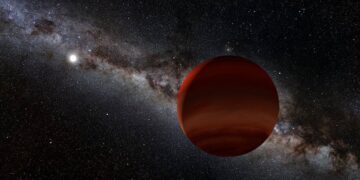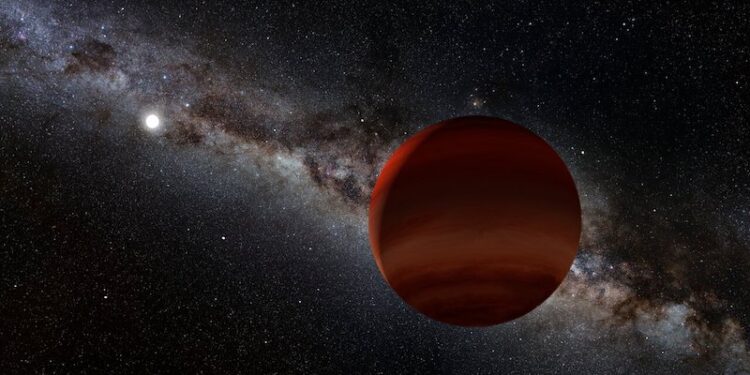In a groundbreaking discovery, NASA’s James Webb Space Telescope (JWST) has revealed brown dwarfs with protoplanetary disks in the Orion Nebula, providing an exceptional view of early stages of planet formation. These observations highlight how planet formation might occur even around smaller, less luminous celestial bodies, marking a significant leap forward in understanding the diversity of planetary systems
The Background of Brown Dwarfs and Protoplanetary Disks
Brown dwarfs are celestial bodies that fall between planets and stars in mass. Often described as “failed stars,” they are not massive enough to sustain nuclear fusion, the process that powers stars. Protoplanetary disks, on the other hand, are gas and dust disks surrounding young stars. These disks are the birthplace of planets, as particles within the disk collide and coalesce over time.
In star-forming regions like the Orion Nebula, which is located 1,300 light-years away and holds about 2,000 newborn stars, intense ultraviolet (UV) radiation from massive stars lights up the surrounding protoplanetary disks, also called proplyds. While Hubble provided initial insights into these disks in the 1990s, it lacked the sensitivity to confirm if faint disks around low-mass brown dwarfs could foster planets. JWST, with its advanced infrared imaging and spectroscopy, now sheds light on this question.
The Observations with the James Webb Telescope and Hubble
The team, led by astronomers from Penn State, made the breakthrough by utilizing JWST’s Near-Infrared Camera (NIRCam) and Near-Infrared Spectrograph (NIRSpec). JWST’s sensitivity allowed the astronomers to distinguish brown dwarfs by measuring their lower temperatures, which fall below those of traditional stars. Webb’s instruments even identified disks around brown dwarfs, which range from 0.5% to 7.5% of our Sun’s mass, putting some brown dwarfs on the boundary between planet and star.

By examining brown dwarfs in Orion, the researchers confirmed 20 of them with protoplanetary disks. With two faint proplyds identified from previous Hubble images, the team confirmed that JWST’s infrared capabilities are crucial for detecting these cold, low-mass objects.
Scientific Implications and the Formation of Brown Dwarfs
This discovery challenges previous models of star and planet formation, demonstrating that even brown dwarfs—objects without enough mass to initiate fusion—can retain disks with planet-forming material. This expands our understanding of where planets can form, pushing beyond the traditional view that only stars can harbor planets.
Brown dwarfs occupy a unique place in the celestial hierarchy, and the exact mechanics of their formation remain under investigation. The prevalent theory suggests that brown dwarfs, like stars, form from the collapse of gas clouds in star-forming regions but fail to accumulate the mass necessary to sustain fusion. In dense environments like Orion, the intense UV radiation from massive stars is thought to hasten the dispersal of these disks, affecting brown dwarfs’ ability to retain planet-forming material.
Brown Dwarfs and Potential Planet Formation
The discovery raises intriguing questions about the potential for planets to form around brown dwarfs. Since protoplanetary disks are essential to planet formation, the existence of such disks around brown dwarfs implies they may host planets. Though brown dwarf planets would likely be gas giants or icy worlds due to limited material, they would represent a distinct class of planetary systems.
Notably, the proplyds around brown dwarfs in Orion hint at the possibility of these bodies forming planets under certain conditions. JWST’s discovery of disks around the smallest brown dwarfs in Orion suggests that protoplanetary disk retention is possible even in harsh UV environments, contributing to the theory that brown dwarfs could host their own planetary systems. This possibility presents an exciting new area for exoplanet studies and understanding planetary diversity across the universe.
The Orion Nebula’s Role in Brown Dwarf Research
The Orion Nebula has been central to many astronomical discoveries, acting as a stellar nursery where stars and planets are born. The abundance of massive stars in Orion makes it an ideal setting for studying how brown dwarfs and protoplanetary disks react to intense radiation. In this region, JWST’s infrared imaging reveals an environment where brown dwarfs’ disks, though fragile, can still be observed.
The proplyds observed around brown dwarfs in Orion emphasize the nebula’s role as a testing ground for planetary formation theories. In particular, the Webb findings indicate that disk lifetimes might vary greatly depending on radiation exposure, providing insight into how the environment shapes planetary system formation.
Broader Astronomical Context and Implications
The confirmation of brown dwarf protoplanetary disks aligns with ongoing research in other star-forming regions, indicating that planetary formation may not be limited to traditional stars. Brown dwarfs with protoplanetary disks could be widespread, supporting a broader definition of planetary system formation. This redefined scope could inspire future missions focused on identifying and studying planetary disks around faint celestial bodies across the galaxy.
Brown dwarfs have long been objects of intrigue, especially as scientists examine their relationship to planets and stars. JWST’s ability to reveal brown dwarf disks invites a new phase of study where researchers can investigate the mass and composition limits for protoplanetary disks, pushing the boundaries of our knowledge on celestial formations.
Future Research Directions and the Promise of JWST
With JWST’s success in identifying brown dwarf proplyds, astronomers are setting their sights on further exploration. As noted by the study’s lead author, the Orion Nebula alone contains hundreds of potential brown dwarfs awaiting detailed study with JWST. Spectroscopy from the telescope will continue to play a crucial role in determining the composition and temperature of these disks, potentially leading to the discovery of even more planetary system candidates around brown dwarfs.
Future observations will also aim to quantify how radiation intensity affects the disk dissipation rate around brown dwarfs, determining whether brown dwarfs in less UV-rich regions retain their protoplanetary disks longer. These findings could guide upcoming missions and open avenues for interstellar observations, potentially offering glimpses into planetary systems around other brown dwarfs beyond Orion.
Conclusion
NASA’s Webb Telescope’s confirmation of brown dwarf protoplanetary disks marks a groundbreaking step in our understanding of celestial formations, revealing that planets might form around even the smallest of star-like objects. With JWST’s unparalleled imaging capabilities, we are now positioned to explore these low-mass objects in unprecedented detail, paving the way for more discoveries that could reshape our understanding of planetary systems and the fundamental processes governing their formation.
Reference:
K. L. Luhman et al, JWST/NIRSpec Observations of Brown Dwarfs in the Orion Nebula Cluster



















